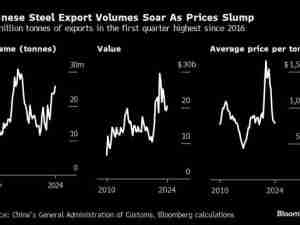Lack Luster Fourth-Quarter Growth Typical of Obama Era as Trump Tests Limits
By: Shobhana Chandra | Jan 26 2017 at 05:00 AM | International Trade
The U.S. economy probably finished the Obama era with a performance typical of the almost eight-year expansion: growth near 2 percent, with consumer spending in the driver’s seat and little help from business investment or trade.
Gross domestic product grew at a 2.2 percent annualized rate in the October-December period, according to the median estimate of economists in a Bloomberg survey ahead of Commerce Department data due Friday. Household spending, which accounts for almost 70 percent of the economy, likely rose at a 2.5 percent pace, also close to the average since the recession ended in 2009, while corporate outlays may have provided a small gain and the trade deficit a minor drag.
The questions now turn to whether the growth drivers remain intact, and the drags can be diminished, as Donald Trump tests their limits in an expansion that’s about to become the nation’s third-longest on record.
The president’s goal of doubling GDP gains likely requires faster consumer spending—something he aims to stoke through lower taxes and more jobs—and reducing the gap between exports and imports, which he’s trying to address by revamping trade policy. A revival in business investment would also help, potentially spurred by Trump’s plans to rebuild infrastructure, reform the tax system and loosen regulations.
“The expansion in the last few years was driven almost exclusively by consumer spending, while business investment was stagnant,” said Stephen Stanley, chief economist at New York-based Amherst Pierpont Securities LLC, and a former Federal Reserve researcher.
Should consumer outlays remain strong and businesses join in, that “would allow the economy to grow faster,” Stanley said. “There’s a likelihood of a significant tailwind from fiscal policy.”
The pace of household spending, while slowing, is still healthy, coming after the best back-to-back quarters since 2014. Trump has promised to cut tax rates “massively” including for the middle class. While that would help put more money into Americans’ pockets, higher gasoline costs in recent months may erode some purchasing power.
Business investment may also be in for a pickup after a long, sluggish stretch, provided Trump’s plan to spend on improving infrastructure gets off the ground and efforts to ease regulations deliver enough incentives. The most significant boost, however, would come from successful corporate tax reforms, economists said.
Business Spending
Corporate spending on equipment, which fell at a 4.5 percent annualized pace in the third quarter for the fourth consecutive decline, may have instead posted a “small” increase in the most recent period, Stanley estimates.
The trade deficit may have widened in the final three months of the year, economists project. That would be a swing back from a sharp narrowing in the third quarter, when net exports provided the biggest contribution to GDP growth since late 2013, thanks to a surge in overseas sales of American soybeans.
Economists see limited scope to significantly shrink the trade gap this year. For exports, expectations of further Fed interest-rate increases mean the strong dollar may remain a headwind, while overseas markets are still weak relative to U.S. growth.
American exporters and manufacturers may also face hurdles at a time of rising, cheaper imports. Trump has pulled the U.S. out of the proposed Trans-Pacific Partnership, and plans to renegotiate the North American Free Trade Agreement with Canada and Mexico.
“Any significant disruptions to trade could weigh on the U.S. manufacturing sector, which Trump is trying to revitalize,” Michael McDonough, chief economist for Bloomberg Intelligence, said in a research note. “Trump’s blueprint to drive growth through fiscal and foreign policy may prove to be a mixed bag.”
Read here about the indicators that will show if Trump is making America great
At the same time, the economy will benefit from the fading of other recent drags, such as cutbacks in mining and exploration related to the global plunge in oil prices. And the surge in post-election confidence among consumers and businesses bodes well for domestic demand in early 2017.
“We anticipate that rising momentum is likely to continue at least through” the first quarter, Citigroup Inc.’s Andrew Hollenhorst and Andrew Labelle said in a note. “While recent data give us a firmer read on the trajectory of the economy in the first half of 2017, assessing the medium-term outlook is complicated by the potential for fiscal stimulus in late 2017 and beyond. This should keep markets carefully attuned to U.S. political developments.”
Any boost would give the expansion—at 90 months as of December—another lease on life. After March, it would be the third-longest on record, and by mid-2018, the second-longest, behind only the 10-year period that spanned the 1990s. Since the end of World War II, the average has been just shy of five years.
“We’re getting closer to the record” in terms of a lengthy expansion, Stanley said. “It’s not unreasonable to think we could get there.”

